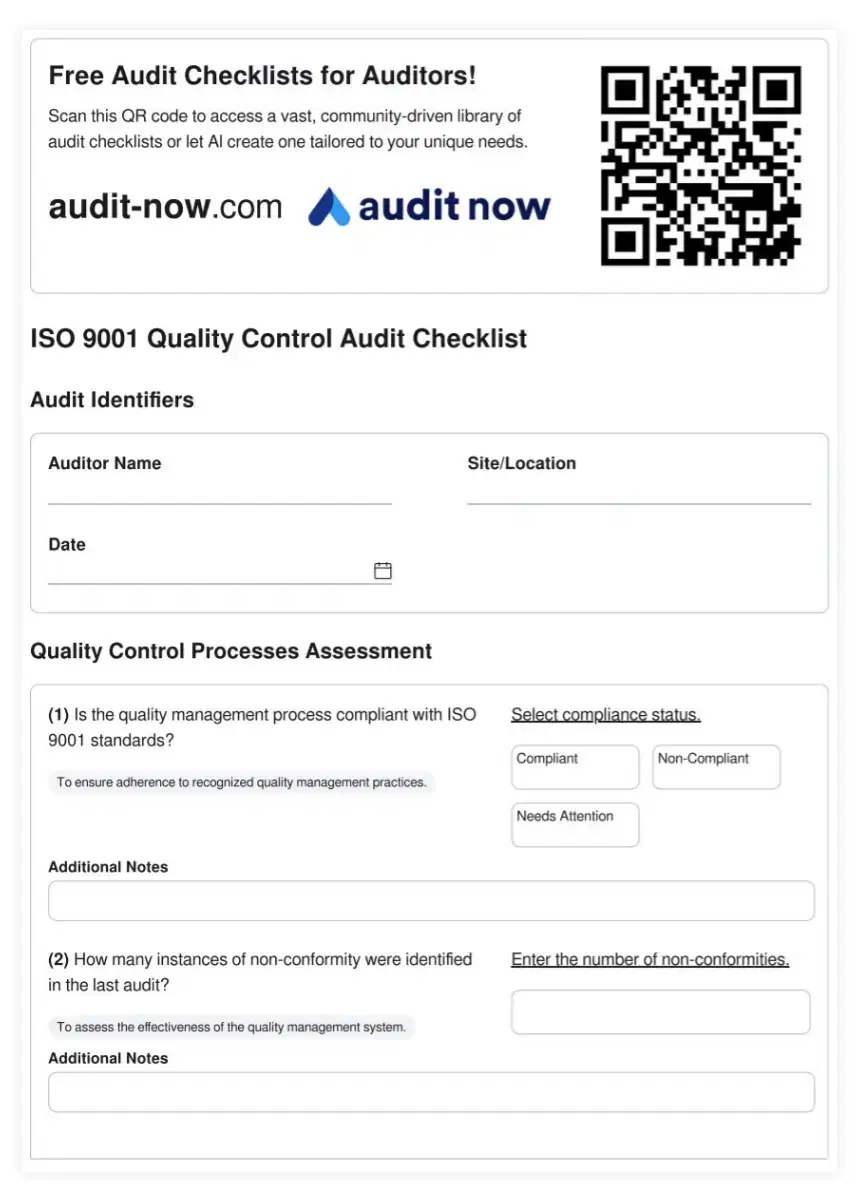Automotive Design and Manufacturing: Driving Excellence Through Audits

Featured Checklist

ISO 9001 Automotive Ergonomics and Human Factors Audit Checklist
In the competitive automotive industry, vehicle ergonomics and human factors play a crucial role in user satisfaction, safety, and overall product quality. This ISO 9001 Automotive Ergonomics and Human Factors Audit Checklist is designed to ensure that automotive manufacturers integrate ergonomic principles and human-centered design throughout the vehicle development process. By systematically evaluating aspects such as driver comfort, control accessibility, visibility, and cognitive load, this checklist helps manufacturers create vehicles that are not only compliant with ISO 9001 quality standards but also optimized for human use and interaction. Regular implementation of this tool can lead to improved user experience, enhanced safety features, reduced driver fatigue, and increased customer satisfaction in the evolving automotive market.
The Automotive Design and Manufacturing Landscape
Automotive design and manufacturing facilities are at the forefront of innovation, constantly pushing boundaries to create safer, more efficient, and technologically advanced vehicles. These workspaces are hubs of creativity and precision engineering, where concepts transform into tangible products that shape our transportation future.
From sleek design studios to state-of-the-art production lines, these facilities encompass a wide range of activities. Engineers and designers collaborate to conceptualize new models, while skilled technicians and workers bring these visions to life through cutting-edge manufacturing processes.
Key Areas of Focus in Automotive Facilities
Design and Prototyping
In the design phase, teams utilize advanced CAD software and virtual reality tools to create and refine vehicle concepts. Prototyping involves 3D printing and CNC machining to produce physical models for testing and evaluation.
Manufacturing and Assembly
The heart of automotive facilities lies in their manufacturing capabilities. Robotic assembly lines, precision welding stations, and paint shops work in harmony to produce vehicles at scale. Quality control checkpoints are integrated throughout the process to ensure each component meets stringent standards.
Testing and Quality Assurance
Before vehicles hit the road, they undergo rigorous testing. Wind tunnels, crash test facilities, and emissions labs play crucial roles in validating design and safety features. Quality assurance teams meticulously inspect each vehicle to maintain brand reputation and customer satisfaction.
Core Audit Requirements for Automotive Facilities
Audits are essential for maintaining operational excellence in automotive design and manufacturing. They ensure compliance with industry standards, improve efficiency, and uphold quality across all processes. Key audit focus areas include:
- Safety Protocols: Ensuring workplace safety measures are in place and followed
- Quality Management Systems: Verifying adherence to ISO 9001 and IATF 16949 standards
- Environmental Compliance: Checking conformity with ISO 14001 and local environmental regulations
- Supply Chain Management: Assessing supplier quality and delivery performance
- Production Efficiency: Evaluating lean manufacturing practices and waste reduction efforts
Importance of Checklists for Operational Excellence
Checklists play a vital role in maintaining consistency and thoroughness in automotive audits. They serve as comprehensive guides, ensuring no critical aspect is overlooked during inspections. Well-designed checklists:
1. Standardize audit processes across different departments and facilities
2. Provide clear criteria for evaluating compliance and performance
3. Facilitate data collection for trend analysis and continuous improvement
4. Serve as training tools for new auditors and employees
5. Help in quick identification of non-conformities and areas for improvement
Industry Standards and Methods in Automotive Auditing
Automotive design and manufacturing facilities adhere to various standards and methodologies to ensure quality, safety, and efficiency. Some key standards include:
ISO 9001 and IATF 16949
These quality management system standards are fundamental in the automotive industry. They focus on continuous improvement, defect prevention, and reducing variation in the supply chain.
VDA 6.3
This German standard for process audits is widely used in the automotive sector. It evaluates the effectiveness and efficiency of processes throughout the product lifecycle.
Six Sigma and Lean Manufacturing
These methodologies are employed to reduce defects, minimize waste, and optimize production processes. Audits often assess the implementation and effectiveness of these practices.
APQP (Advanced Product Quality Planning)
This framework guides the product development process in the automotive industry. Audits ensure that APQP principles are followed from concept to production.
Talk to an Expert
Have questions about the techniques and methods? Contact our experts for free advice!
Contact
Challenges in Automotive Facility Auditing
Auditing automotive design and manufacturing facilities comes with unique challenges:
1. Keeping pace with rapidly evolving technologies and production methods
2. Balancing efficiency with thorough inspection in high-volume production environments
3. Coordinating audits across global supply chains and multiple facilities
4. Ensuring consistency in audit practices across different regions and regulatory frameworks
5. Adapting to new sustainability and electrification requirements in the industry
Streamlining Audits with Digital Solutions
To address these challenges and enhance operational excellence, Audit Now offers a comprehensive digital platform tailored for automotive design and manufacturing facilities. Our solution revolutionizes the audit process with:
- AI-powered checklists that adapt to specific facility needs and industry standards
- Real-time collaboration tools for seamless communication between audit team members
- Automated reporting features that generate instant, actionable insights
- A vast template library covering various automotive audit types and standards
Implementing Audit Now is straightforward:
1. Visit audit-now.com to explore our platform
2. Access our extensive template library at https://audit-now.com/templates/
3. Customize checklists using our AI-powered generator at https://audit-now.com/generate-ai-checklist/
4. Integrate the platform into your existing workflows for immediate efficiency gains
With Audit Now, automotive facilities can streamline their audit processes, ensure compliance, and drive continuous improvement. Experience the future of auditing in the automotive industry – where precision meets innovation.